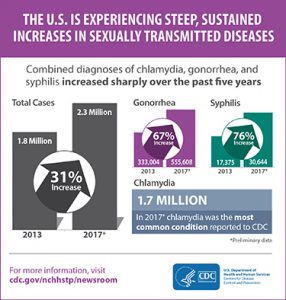New data released today from the Centers for Disease Control and Prevention (CDC) reveal that STD rates continue to climb in the U.S., with nearly 2.3 million cases reported to CDC. The data on five year trends in reported STDs show that increases in STDs have continued for four consecutive years. From 2013-2017:
 As Gail Bolan, MD, Director of the Division of STD Prevention at CDC commented, “After decades of declining STDs, in recent years, we’ve been sliding backwards. In addition to these sharp increases, we’re also facing new challenges that we must address like the potential link between STD risk and drug use and the ongoing threat that gonorrhea will eventually wear down our last highly effective antibiotic.”
As Gail Bolan, MD, Director of the Division of STD Prevention at CDC commented, “After decades of declining STDs, in recent years, we’ve been sliding backwards. In addition to these sharp increases, we’re also facing new challenges that we must address like the potential link between STD risk and drug use and the ongoing threat that gonorrhea will eventually wear down our last highly effective antibiotic.”
While striking, the data on reported STDs is only part of the story. Many cases go undiagnosed and untreated, and the consequences of untreated infections can be severe. While chlamydia, gonorrhea, and syphilis are curable with antibiotics, complications of untreated infection include infertility, ectopic pregnancy, stillbirth in infants, and increased HIV risk.
Also important to note is the fact that STDs impact some groups more than others. Men who have sex with men (MSM) made up almost 70 percent of primary and secondary syphilis, and young women 15-24 made up about 45 percent of the 1.7 million reported cases of chlamydia.
In a press briefing announcing the release of the new data, Bolan noted the importance of following CDC’s recommendations for screening. As she stated, “We recommend that all sexually active women less than the age of 25 go in and get checked for chlamydia and gonorrhea on an annual basis. We recommend that men who are having sex with men, go in and get checked at least annually for sexually transmitted diseases…We just need to get our providers doing sexual histories and doing the appropriate screening and we need to have clients who come in and access care to be asking, do I need to be – everyone needs to ask their doctor, should I be tested for STDs, I hear they’re going up. So, have that conversation.”
Learn more about screening for STDs and how to talk to your healthcare provider about your sexual health.